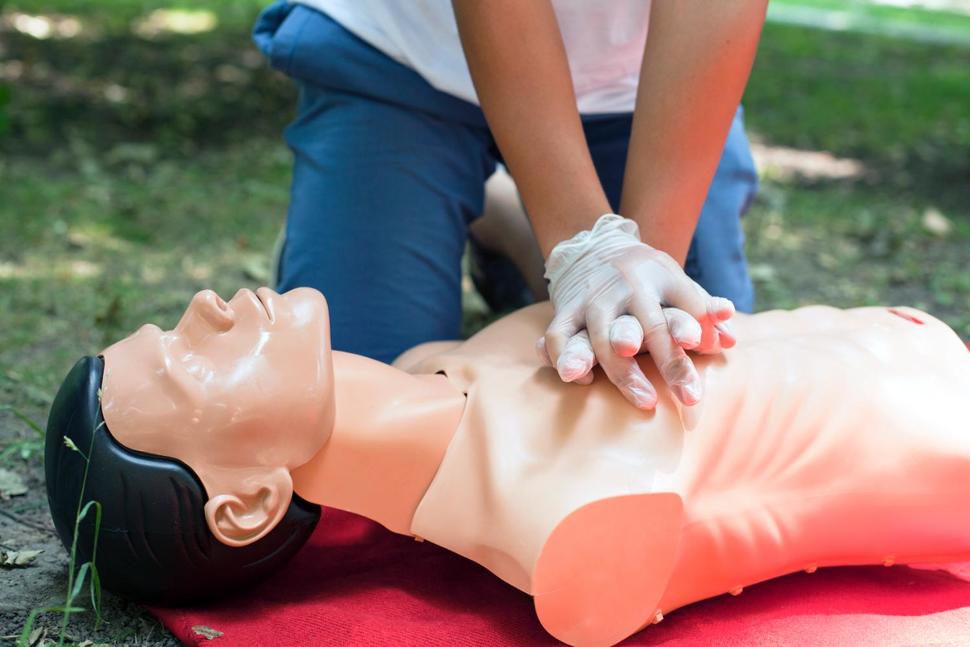Sudden Cardiac Death Survival, Bystander CPR And AEDs: A Call To Action For Every American

CPR is simple to learn and can have an enormous impact on survival. (iStockPhoto)
Heart disease kills more people than all types of cancer combined. Every year, nearly 450,000 Americans die suddenly from cardiac arrest. Nearly 88 percent of cardiac arrests occur at home, and the survival rate for an out-of-hospital sudden cardiac death is only 7 percent but can be significantly increased with prompt activation of the 911 emergency system and bystander intervention. The majority of these arrests are due to coronary artery disease, and others are due to certain types of structural heart disease and genetic disorders, or they may be secondary to other medical problems. When a cardiac arrest occurs, the heart beats erratically (called ventricular fibrillation), and no longer is able to pump blood and oxygen to the brain and other organs. Studies have shown that early cardiopulmonary resuscitation, or CPR, and the use of an automated external defibrillator by bystanders who witness the arrest can significantly improve survival. AEDs allow lay people to provide a lifesaving shock to a patient who is dying from cardiac arrest.
While we know that CPR saves lives, few Americans are trained in these lifesaving techniques. According to the American Heart Association, 80 percent of Americans do not know how to perform CPR. Even more concerning is the fact that in some communities, less than 15 percent of bystanders will perform CPR in an emergency situation. In sharp contrast to the U.S., in some European countries public health initiatives have proven successful in bolstering the numbers of trained citizens. In fact, data from Denmark has shown that increases in bystander CPR have resulted in a significant increase in survival among cardiac arrest victims. The availability of AEDs is also an issue – these devices are not always easily accessible. A recent study published in Circulation found that when AEDs are placed in coffee shops and near ATMs, outcomes improve – suggesting that if we have easy access to lifesaving devices, we are more likely to act. When we act, survival rates improve.
The Importance of CPR
CPR is simple to learn and can have an enormous impact on survival. As mentioned, nearly 88 percent of all cardiac arrests occur at home, so it's very likely that the life you save may be that of a relative or friend. When we perform CPR, we're able to circulate blood to the brain and keep the patient alive until EMS arrives. Every second after a cardiac arrest is critical, and the chances of survival diminish exponentially after 4 to 6 minutes without CPR. In fact, for each minute a patient goes without bystander initiated CPR, survival rates decrease by 7 to 10 percent. When CPR is quickly initiated, the rate of survival improves significantly. The American Heart Association sponsors inexpensive certification courses in nearly every single community in the U.S. When taking a CPR class, you'll learn the basics of how to treat a patient with a cardiac arrest – including chest compressions, rescue breathing and, most importantly, how to use an AED.
The Role of the AED
An AED is a device that allows bystanders to provide lifesaving treatment to a cardiac arrest victim. These devices are completely automated and provide verbal instructions to the user. When opened and switched on, the device provides verbal instructions to the user so a lifesaving shock can be administered to a patient in cardiac arrest. When AEDs are utilized in an out-of-hospital arrest, survival rates can approach more than 50 percent, according to numerous studies. AEDs are becoming more prevalent in schools, public buildings, golf clubs and restaurants. It's essential that all personnel know where to locate the devices and how to use them. By increasing the numbers of trained citizens, we can increase the likelihood of survival for those suffering a cardiac arrest.
What Can We All Do?
It's crucial for each of us to learn CPR and become comfortable enough to respond in an emergency.
- Find a local CPR training course. Reach out to your local American Red Cross or check online with the American Heart Association. In addition, many local hospitals and community centers can point you in the right direction.
- Learn CPR. Sign up and take a course. Bring a friend or family member with you to train, as well. Study the manual and participate in the class. Ask questions, and make sure you're prepared in an emergency.
- Practice/recertify. Just as with any other skill set, it's important to practice and review. Your CPR certification is good for two years, but it's important to recertify when necessary. Review your manual and practice as needed.
- Be ready to act. When an emergency occurs, remember your training. Calmly activate the 911 emergency response system and begin bystander CPR. Ask others around you to help, and make sure to use an AED if available.
CPR saves lives. As bystanders, we must do a better job getting involved when an arrest occurs. While nearly 400,000 Americans die annually from sudden cardiac death, it's likely we can significantly impact this number by advocating for CPR training for all and making sure that AEDs are available in all public places.
Story Credit: http://health.usnews.com/health-care/for-better/articles/2017-04-06/sudden-cardiac-death-survival-bystander-cpr-and-and-aeds-a-call-to-action-for-every-american


